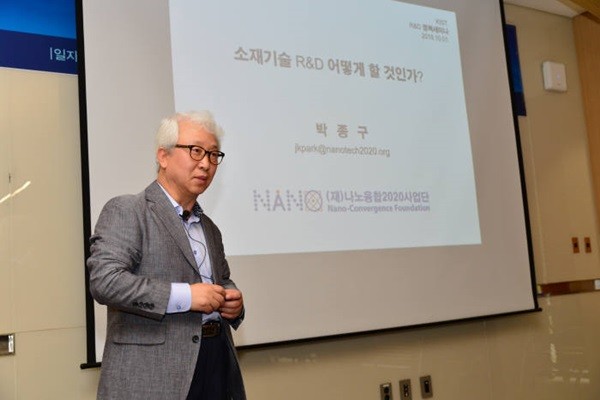“Solutions are becoming more important than individual technology in order to apply new materials technology to finished products. Laboratories as well as individual researchers must become competitive platforms. Comprehensive strategies through joint research are also important.” said Park Jong-ku who is the head of Nano-Convergence Foundation during a seminar that was held by KIST (Korea Institute of Science and Technology) for its employees.
As localization of materials has become a major topic within industries since Japanese Government enforced its regulation, Park Jong-ku presented a direction for South Korea’s manufacturing industry for the future and a direction on how R&D process on materials technology should be pursued corresponding to the direction of South Korea’s manufacturing industry.
He pointed out weakened added value of the manufacturing industry, generalization of GVC (Global Value Chain), and rapid lifecycles of products as issues that must be addressed through materials technology. He predicted that fast response, personalization, intellectualization, sustainability, and combination of products and services will be key trends for manufacturing industry in the future.
“Because the lifecycle of a product is being shortened to two to three years when it took 20 years before new materials such as CNT (Carbon Nano-Tube) and QD (Quantum Dot) were actually used, we need to think about how to match the lifecycle of a product to development period.” said Park Jong-ku. “Strategies by the U.S., Japan, Germany, and China are efforts to increase the success rate of development of materials so that they do not hold back the development of their respective manufacturing industries and to reduce development period and cost so that they can be even one step forward than other countries.”

Recent trend on the development of materials is centered on rediscovery and improvement of materials rather than looking for original material. Graphene, which is considered as a dream material, is a typical rediscovered material. Park Jong-ku emphasized that technologies that change the current structure of a material or convert materials into composite materials are the most important.
“Because there needs to be an appropriate equipment or instrument when finding a new material and developing a corresponding technology, we need to consider materials and equipment together when developing a materials technology.” said Park Jong-ku. “Changing evaluation on tasks, R&D system, and researcher evaluation system so that the development of an equipment takes place at the same time as the development of a material can truly produce accurate political effect.”
As industries are becoming more advanced, industries are requesting ‘paradox materials’ that cannot be comprehended with current concepts. Also, companies are requesting solutions that can be applied right away to reduce development period. Park Jong-ku emphasized that individual researcher and research institutes must become competitive platforms in order to secure appropriate abilities in materials technology. He also put an emphasis on presenting solutions by combining individual research.
“Because companies are concerned about products that will be released in just six months and do not have resources to develop materials that will take 20 to 30 years, they want solutions that can put out a fire right away.” said Park Jong-ku. “There needs to be synergy through joint research and there is a need for a company and an institution that has processing technology to work together.”
Staff Reporter Jung, Hyeonjung | iam@etnews.com